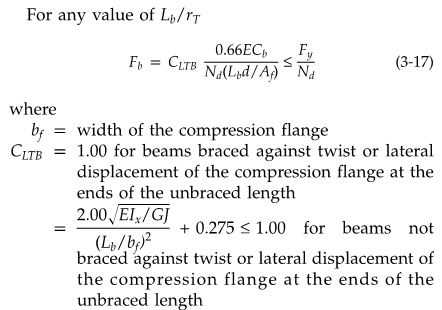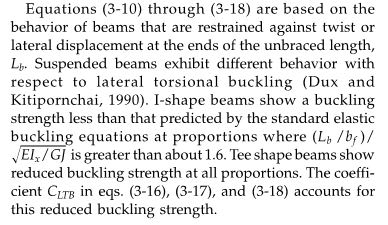WARose
Structural
- Mar 17, 2011
- 5,594
Have been doing some lift/spreader beam designs lately.....and one thing has been bugging me (and not for the first time): the buckling value vs. cable angles in a lot of these papers.
The 2 primary papers I use are:
1. 'Distortion Buckling of Steel Beams' by: Essa & Kennedy. University of Alberta Department of Civil Engineering, April 1993'. (p.206-210)
2. 'Buckling of Suspended I-Beams.', by: Dux & Kitipornchai, (1990). ASCE Journal of Structural Engineering,
116(7), 1877–1891
Ref #1 doesn't have anything with the hanging cables at a angle (just 90 degrees with the horizontal)......but Ref# 2 does. It gives the "nondimensional buckling load" based on several parameters....including the angle the cables are at. Looking at the figures in Ref.2, you get a great deal of variation based on that angle. And it's hard to always match your situation to the tables in that reference.
My suspicion is: the variation has to do with the imposed loading as much as anything. (I.e. the angle involved changes the major axis moment, axial load, etc, and that is accounted for.)
Reinforcing that suspicion is the following statement in Ref #2:
For all cable angles, the curves in Fig. 7 feature severe reductions in buckling
capacity as loads move even some small distance from the optimum
location. This highly sensitive reduction is due primarily to increases in the
extent and magnitude of major axis bending moment patterns. This, combined
with the relatively ineffective partial torsional restraints, causes the
reduction in buckling strength. This feature of behavior should be borne in
mind by designers, as it is not usual for small alterations in loading configurations
to have such a significant effect.
So I guess what I am asking is, by Ref#1 (with all other things being equal and all cable attachments being nowhere near the shear center): can you figure one of these things with the cable angles at 90 degrees and be confident you are getting a strong axis buckling load that cannot be exceeded (with the proper SF)?
Granted, if you do so, you will need to superimpose other loads that this is not taking into account (i.e. axial, strong-axis, accidental weak axis, etc.). But I just want to be sure about a buckling load here.
The 2 primary papers I use are:
1. 'Distortion Buckling of Steel Beams' by: Essa & Kennedy. University of Alberta Department of Civil Engineering, April 1993'. (p.206-210)
2. 'Buckling of Suspended I-Beams.', by: Dux & Kitipornchai, (1990). ASCE Journal of Structural Engineering,
116(7), 1877–1891
Ref #1 doesn't have anything with the hanging cables at a angle (just 90 degrees with the horizontal)......but Ref# 2 does. It gives the "nondimensional buckling load" based on several parameters....including the angle the cables are at. Looking at the figures in Ref.2, you get a great deal of variation based on that angle. And it's hard to always match your situation to the tables in that reference.
My suspicion is: the variation has to do with the imposed loading as much as anything. (I.e. the angle involved changes the major axis moment, axial load, etc, and that is accounted for.)
Reinforcing that suspicion is the following statement in Ref #2:
For all cable angles, the curves in Fig. 7 feature severe reductions in buckling
capacity as loads move even some small distance from the optimum
location. This highly sensitive reduction is due primarily to increases in the
extent and magnitude of major axis bending moment patterns. This, combined
with the relatively ineffective partial torsional restraints, causes the
reduction in buckling strength. This feature of behavior should be borne in
mind by designers, as it is not usual for small alterations in loading configurations
to have such a significant effect.
So I guess what I am asking is, by Ref#1 (with all other things being equal and all cable attachments being nowhere near the shear center): can you figure one of these things with the cable angles at 90 degrees and be confident you are getting a strong axis buckling load that cannot be exceeded (with the proper SF)?
Granted, if you do so, you will need to superimpose other loads that this is not taking into account (i.e. axial, strong-axis, accidental weak axis, etc.). But I just want to be sure about a buckling load here.


